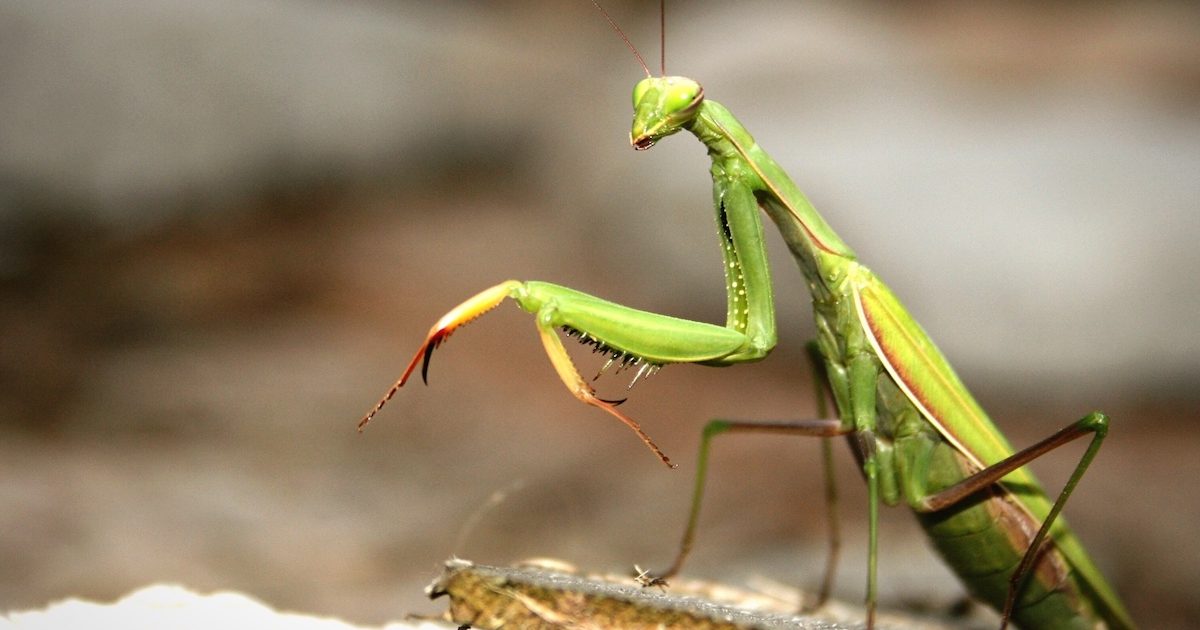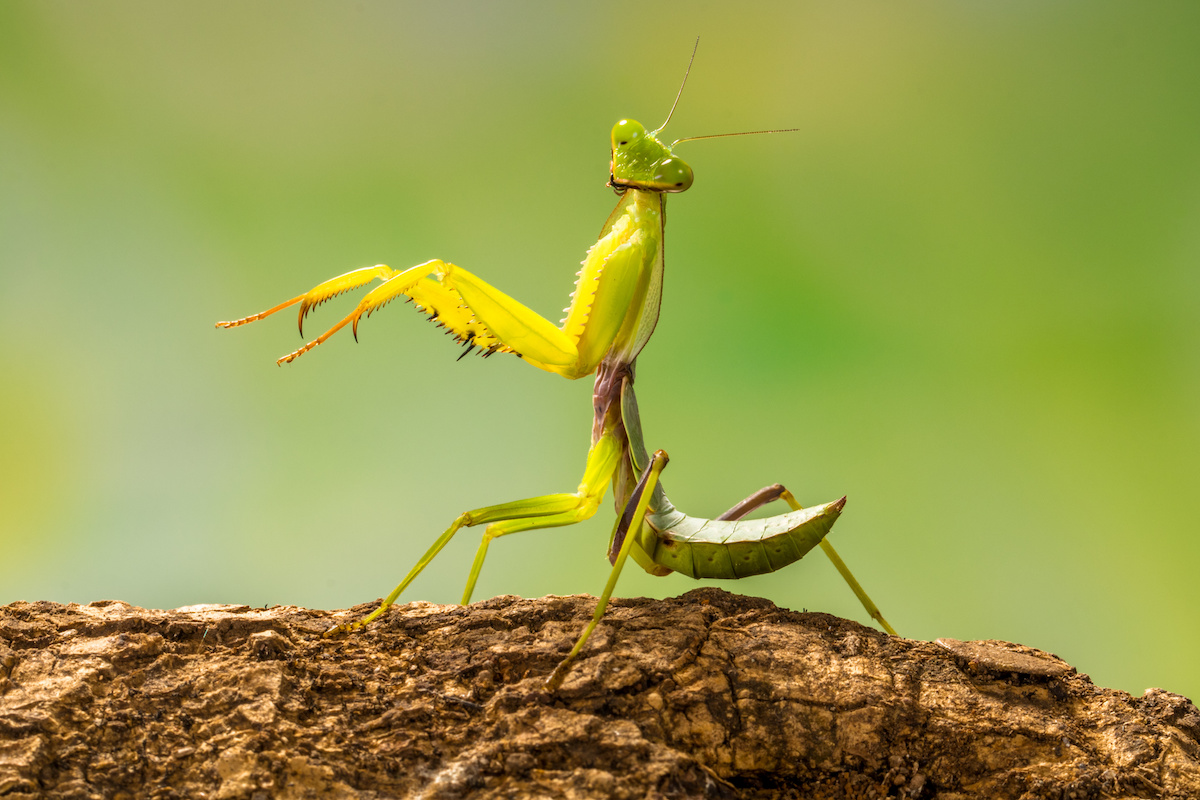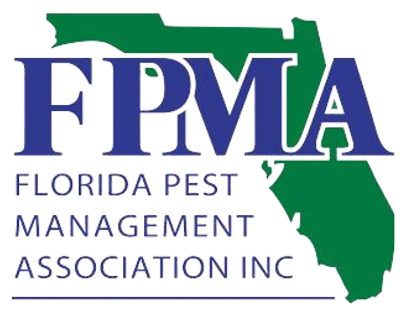
As Floridians, we are fortunate to be surrounded by a multitude of species of plants and animals. From the gentle manatee to the majestic bald eagle, our state is a veritable treasure trove of wildlife. But one species that often goes overlooked is praying mantises in Florida, a fascinating insect that calls our state home.
In this article, we’ll explore the world of praying mantises in Florida, from the different types of species to how to protect them. So, let’s take a closer look at these incredible creatures and discover the wonders of praying mantises in Florida!
What is a Praying Mantis?
Praying mantises are an insect of the order Mantodea, which is made up of about 2400 species of mantises found in tropical, subtropical, and temperate regions around the world. They are known for their signature “prayer-like” stance, which is how they got their name.
A praying mantis is typically slender, long-legged, and has large triangular heads with bulging eyes. They have long, slender antennae and powerful, raptorial forelegs that are used to capture prey. The front legs of the mantis are typically in an upright praying position.
Praying mantises are predatory insects and their diet consists mainly of small insects such as flies, mosquitoes, beetles, and moths. They are also capable of catching and eating larger prey, such as lizards and frogs. Mantises are solitary and territorial, and will fiercely defend their territory from other mantises.
Types of Praying Mantis In Florida
There are several species of praying mantises in Florida, including the Florida mantis. The Florida mantis is the most common species in the state and is easily identifiable by its bright green color. This species of mantis is found in the central and southern parts of the state.
Also in Florida, the Chinese mantis is native to Asia but has been introduced to Florida and is now found across the state. It is larger than the Florida mantis and is typically grey or brown in color.
The European mantis is an invasive species for Florida. It can grow up to 3.5 inches long and can tolerate the high temperatures of our state. You will typically find them living in grassy areas and shrubbery.
Where to Find Praying Mantis in Florida
Praying mantises can be found in many different habitats in Florida. They live in woodlands, fields, gardens, and even urban areas.
In woodlands, the Florida mantis makes itself at home in the leaf litter on the ground. The Chinese mantis is typically spending time in trees and shrubs, while the Caribbean mantis hides in low-lying vegetation or on the ground.
Mantises also live in gardens and urban areas, gravitating to flowers and other sources of nectar.
Habitat and Diet of Praying Mantis in Florida
Praying mantises in Florida prefer warm and humid habitats and will often seek shelter in nearby trees or shrubs. They also enjoy areas with plenty of foliage, which provides them with protection and places to hide while they hunt for prey.
Meanwhile, praying mantises are carnivorous and their diet consists mainly of small insects such as flies, mosquitoes, beetles, and moths. They are also capable of catching and eating larger prey, such as lizards and frogs. Mantises are solitary hunters and will fiercely defend their territory from other mantises.
Interesting Facts about Praying Mantises in Florida
Praying mantises in Florida are one of the most fascinating creatures in our state. Here are some interesting facts about them:
- Praying mantises have a unique method of eating their prey. After catching an insect, they will use their powerful forelegs to hold it in place while they bite its head off.
- These insects are capable of flying, although they are not strong fliers. They use their wings to glide from tree to tree and to catch prey.
- A praying mantis can turn its head 180 degrees and have excellent eyesight, which allows them to spot prey from far away.
- They are the only known insects to see in 3D.
- Praying mantises will often lay their eggs in the late summer or early fall.
Benefits of Praying Mantis in Florida
Praying mantises in Florida are beneficial to humans in several ways. They are a natural pest control, as they feed on insects that can be detrimental to crops, such as aphids and caterpillars. Mantises also help to keep the insect population in check, as they are fierce predators and will consume large numbers of insects.
However, a praying mantis isn’t necessarily your friend. This is because they are just as likely to eat pollinating insects such as bees or butterflies, as they are any other insect.

How to Protect Praying Mantis in Florida
Praying mantises are an important part of the environment, and it’s important to protect them. Here are some tips for protecting praying mantises in Florida:
- Avoid using pesticides and herbicides, as these can be harmful to mantises and other beneficial insects.
- Plant native flowers and shrubs, as this will provide a food source for mantises.
- Leave leaf litter and other debris in your yard, as this provides cover for mantises.
- Leave some areas of your yard undisturbed, as mantises prefer undisturbed areas for nesting.
- If you find a praying mantis, leave it alone, as it’s likely to be a beneficial insect.
What to Do If You Find a Praying Mantis in Florida
If you’re lucky enough to find a praying mantis in Florida, don’t be alarmed! Praying mantises are harmless, and they can be a beneficial addition to your yard. Here are some tips for what to do if you find a praying mantis:
- Leave the mantis alone. Praying mantises are solitary creatures and do not need to be handled.
- If you must move the mantis, use a cup or container to move it.
- Provide the mantis with food and water.
- Offer the mantis with shelter, such as leaves or logs, to hide in.
- Observe the mantis from a distance to enjoy its fascinating behavior.
Do You Have Too Many Praying Mantises Around Your Home?
If you have a praying mantis infestation, the first thing you should do is identify the source of the infestation and try to limit the number of praying mantises in your home. To do this, you can look for any cracks or openings in your home that might be allowing these insects to enter. This can include windows, doors, vents, or other small openings. If you find any of these, you should seal them up to prevent further infestation.
Another method of controlling a praying mantis infestation is to remove any food or water sources that may be attracting them. Shrubbery is one of the main attractions in any yard for praying mantises in Florida. Trimming down or removing shrubbery can help deter these insects.
Finally, if the infestation is severe, you can contact a pest control company to help you get rid of the praying mantis infestation. We can effectively remove these insects and provide tailored advice on how to prevent future infestations. No matter which method you choose to use to get rid of your praying mantis infestation, it’s important to remember to be patient and persistent to ensure that the infestation is eliminated completely.
Praying Mantises in Florida: Get Help from Drive-Bye Exterminators
Praying mantises in Florida are one of the most fascinating creatures in our state. From their “prayer-like” stance to their fierce hunting capabilities, there is much to learn and appreciate about these incredible insects.
These are exotic insects, although some are considered invasive. If you come across an infestation and you aren’t sure how to proceed, please contact us at Drive-Bye Exterminators. We hope this article has helped you to discover the wonders of praying mantises in Florida.






